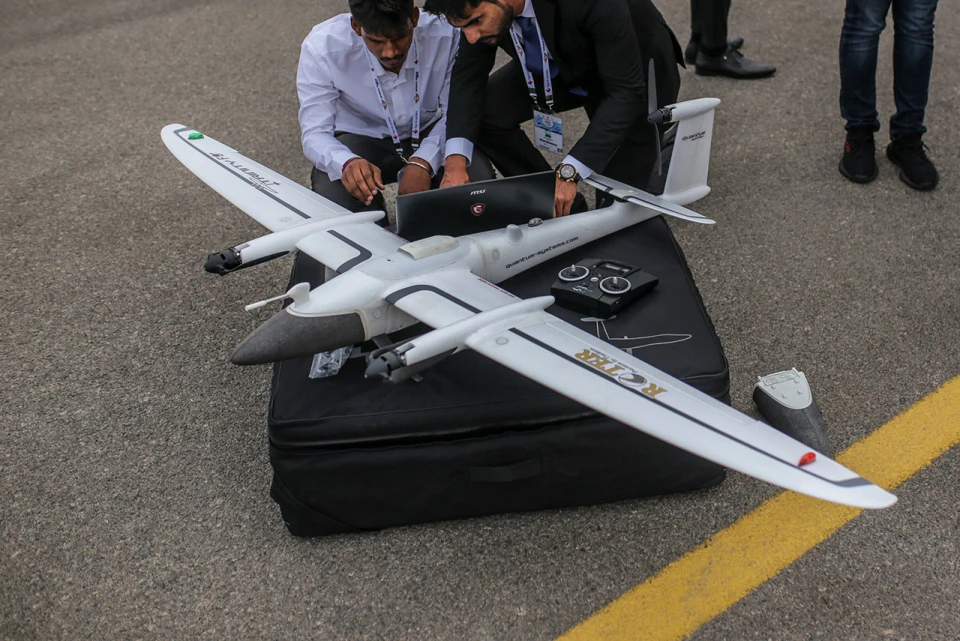
Drones for large-scale territory scanning: what is known about Trinity UAVs donated by Germany to Ukraine
A German drone company has announced that it is donating 100 Trinity drones in various modifications to Ukraine
Espreso explains how these drones stand out from the rest, what their technical characteristics are, and how they will be used in Ukraine.
The text will cover:
- Who will supply the Trinity UAVs and when
- What is Trinity and how it works
- Technical characteristics of Trinity
- How Trinity will be used in Ukraine
Who will supply Trinity UAVs and when
Quantum-Systems has declared its intent to provide Trinity drones to Ukraine. This technology company, based in the community of Gilching, was established in 2015. It specializes in the development, design, and manufacturing of small unmanned aerial vehicles.

Photo: Getty Images
The company has actively participated in Ukraine's defense efforts since entering the country in the summer of 2023. Quantum Systems announced the establishment of service training, support, and logistics centers in Ukraine during that period. To date, Quantum-Systems has been providing Ukraine with Vector reconnaissance drones through the German government. These centers have played a crucial role in training operators on the usage and maintenance of Vector systems. Additionally, they specialize in facilitating the procurement of spare parts for drones and handling drone repairs.
Quantum-Systems has underscored that a hundred drones will be transferred to Ukraine virtually free of charge, as per the contract signed in September 2023 by the company's CEO, Florian Seibel, and Kyiv Mayor Vitali Klitschko. Consequently, the Kyiv authorities will make the ultimate decision regarding the deployment of Trinity.
Last November, a Quantum representative confirmed that they plan to train Ukrainian soldiers on these mapping UAVs in January 2024. As of today, Ukrainian operators have already completed the Trinity instructor training.
What is Trinity and how does it work?
Trinity is the flagship of the Quantum-Systems air fleet. The Trinity prototype made its first flight in 2016. Serial production began in 2018.
Trinity is an airplane-type drone with a Vertical-Take-Off-Landing (VTOL) feature, blending the benefits of both multi-rotor and fixed-wing drones. Notably, it eliminates the requirement for additional equipment such as catapults or parachutes, as well as the need for special runways during takeoff or landing.
During vertical takeoff and landing, all three Trinity engines point upward. After takeoff, the engines tilt forward, and when cruising speed is reached, the two front engines are turned off. Only the rear engine provides thrust for further flight, which saves battery power and ensures a longer flight duration. This configuration, according to the manufacturer, gives the drones high efficiency.
"Thanks to the modular system, the Trinity is airborne within a few minutes and performs automated tactical mapping and terrain visualisation missions. In just one flight, a single drone could cover an area of 700 hectares or a linear corridor of 90 kilometres in length," Quantum-Systems writes.
Depending on the purpose, the drone's payload can include high-resolution cameras, multispectral sensors, or thermal infrared sensors. It is possible to obtain high-resolution images in different spectral ranges in one flight. The payload can be quickly replaced - no tools are required, all cameras and sensors are integrated into the system.
The flight is controlled from a ground station using a laptop. After the operator defines the flight area and task parameters, the program automatically generates the most efficient flight paths. The operator receives all the necessary information (altitude, speed, heading, battery status, etc.) in real time.
Technical characteristics of the Trinity drone include:
- Wingspan: 2.4 meters
- Maximum takeoff weight: 5.75 kg
- Flight duration: Up to 90 minutes
- Flight range: Up to 70 km
- Coverage area for one flight: 700 hectares
- Telemetry: 2.4 GHz with a range of up to 7.5 km
How Ukraine will use Trinity
The basis of the three modifications of the German drone is the Trinity Pro mapping drone. It will be used to accurately record damage to infrastructure, buildings, roads or bridges, for example, after Russian attacks. Drones are ideal for assessing combat damage.
It is also very likely that we will see Trinity on the battlefield. After all, Quantum will provide drones of all modifications. For example, Trinity Tactical, which can be used, for example, to provide real-time images to special forces operating in enemy territory or in isolated areas.
The final decision on how and where the German drones will be used will be made by the Kyiv City Administration, which will receive the UAVs.
"No matter where and how the drones are then deployed by the Ukrainians, we can be sure that they will serve well both on the battlefield and in the cities and actively support the fight against the Russian invaders or civilian reconstruction," the manufacturer's release said.
- News














































